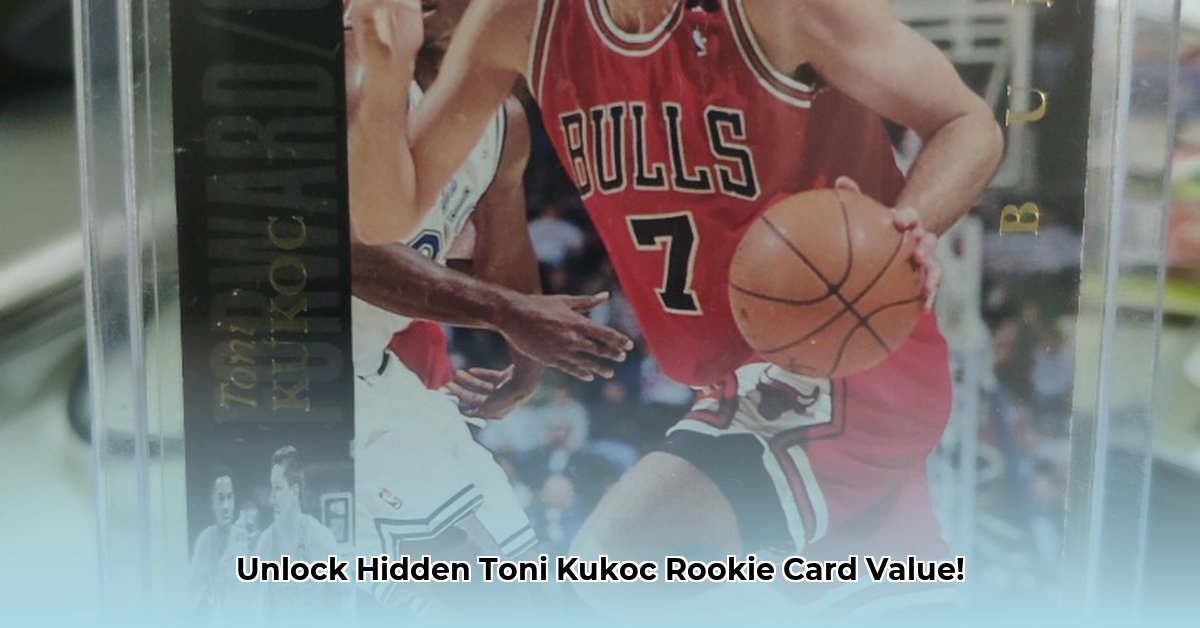
Toni Kukoc Rookie Cards: A Collector's Guide
The world of basketball card collecting is booming, and Toni Kukoc cards offer a compelling niche for both seasoned investors and enthusiastic newcomers. Kukoc's unique blend of European finesse and consistent NBA performance has made his cards highly sought-after collectibles. This guide will equip you with the knowledge and strategies to navigate this market effectively, whether your goal is building a personal collection or making strategic investments.
Understanding Kukoc Card Value: Decoding the Market
The value of a Toni Kukoc card isn't arbitrary; it's a complex equation determined by several key factors. Think of it like appraising a classic car—condition, rarity, and unique features all significantly impact its worth.
Rarity: Limited print runs are the foundation of high value. The fewer cards in existence, the higher the demand and thus the price. A card from a small print run will naturally be more expensive than one from a larger release. Do you know which Kukoc cards were known for exceptionally limited print runs?
Condition: Professional grading companies like PSA (Professional Sports Authenticator) and Beckett Grading Services meticulously assess cards' condition, assigning grades that directly influence their value. A perfectly centered card with sharp corners and no blemishes (a PSA 10) commands significantly more than a damaged or worn one. A PSA 10 card is essentially a "mint" condition card. What grade would you consider the minimum acceptable for a significant investment?
Set: The set from which a Kukoc card originates heavily influences its value. Cards from popular and highly sought-after sets (like 1993 Fleer or Upper Deck) will usually fetch higher prices than those from lesser-known sets. Why is set recognition such a crucial factor in card valuation?
Special Features: Autographs, jersey swatches, and unique inserts (like refractors, which create a shimmering effect) greatly enhance a card's desirability and its resulting price. These are the details that make a card truly exceptional. Are these extra features worth the potentially high premium?
Identifying Key Kukoc Cards: Tiered Value System
Certain Kukoc cards consistently dominate the market. Let's explore some key examples and understand their value:
The 1993 Finest Refractor #14 is frequently cited as a prime example of a high-value Kukoc rookie card. Its refractor technology—creating a shimmering effect—and its status as a rookie card drive intense demand.
Other highly valued cards include various Metal Universe Precious Metal Gems known for their intricate designs and limited releases.
To simplify, consider this tiered value system:
Tier 1 (Highest Value): Cards such as the 1993 Finest Refractor #14 and high-grade Metal Universe Precious Metal Gems command significant premiums due to rarity and desirability.
Tier 2 (Mid-Range Value): Includes high-grade rookie cards from popular sets, offering solid investment potential.
Tier 3 (Lower Value): Includes common rookie cards and lower-grade examples from less popular sets, providing affordable entry points for collectors.
Buying and Selling Strategies: Maximizing Your Returns
Success in the Kukoc card market requires smart buying and selling.
Where to Buy: Reputable sources are key. Explore eBay, specialized card shops, and auction houses. Always verify authenticity. What are the potential red flags to look out for when buying online?
Authenticity Verification: Always verify authenticity—professional authentication services, reputable dealers, and detailed examination can help you avoid counterfeits. What percentage of Kukoc cards on the market are estimated to be counterfeit?
Storage: Maintain the highest possible grade. Use protective sleeves, toploaders, and sturdy storage boxes to preserve condition and maximize value. Proper storage can be the difference between a valuable card and a damaged one. What is an optimal storage setup for preserving Kukoc card value?
Risk Mitigation: Protecting Your Investment
The Kukoc card market has inherent risks:
- Counterfeit Cards: The presence of counterfeit cards is significant. Verify authenticity through reputable sources.
- Market Fluctuations: Card values change. Diversify to mitigate risk.
- Grading Inconsistencies: Different grading companies might have slightly different standards. Comparing grades from multiple companies can give a more well-rounded view of a card's condition.
Mitigation Strategies:
- Authenticate: Only buy from trusted sources and verify authenticity before purchasing.
- Diversify: Don't invest all your resources in just one card or set. Spread investments across different cards and sets to mitigate risk.
- Compare Grades: Get multiple grading opinions from different reputable companies.
- Proper Storage: Invest in proper protective equipment to maintain the integrity of your cards.
Conclusion: Building a Successful Kukoc Card Collection
The Toni Kukoc card market provides exciting opportunities for collectors and investors. Success requires thorough research, diligent authentication, sound buying and selling strategies, and strategic risk mitigation. By understanding what impacts card value and planning ahead, you can cultivate a rewarding and potentially profitable Kukoc card collection.